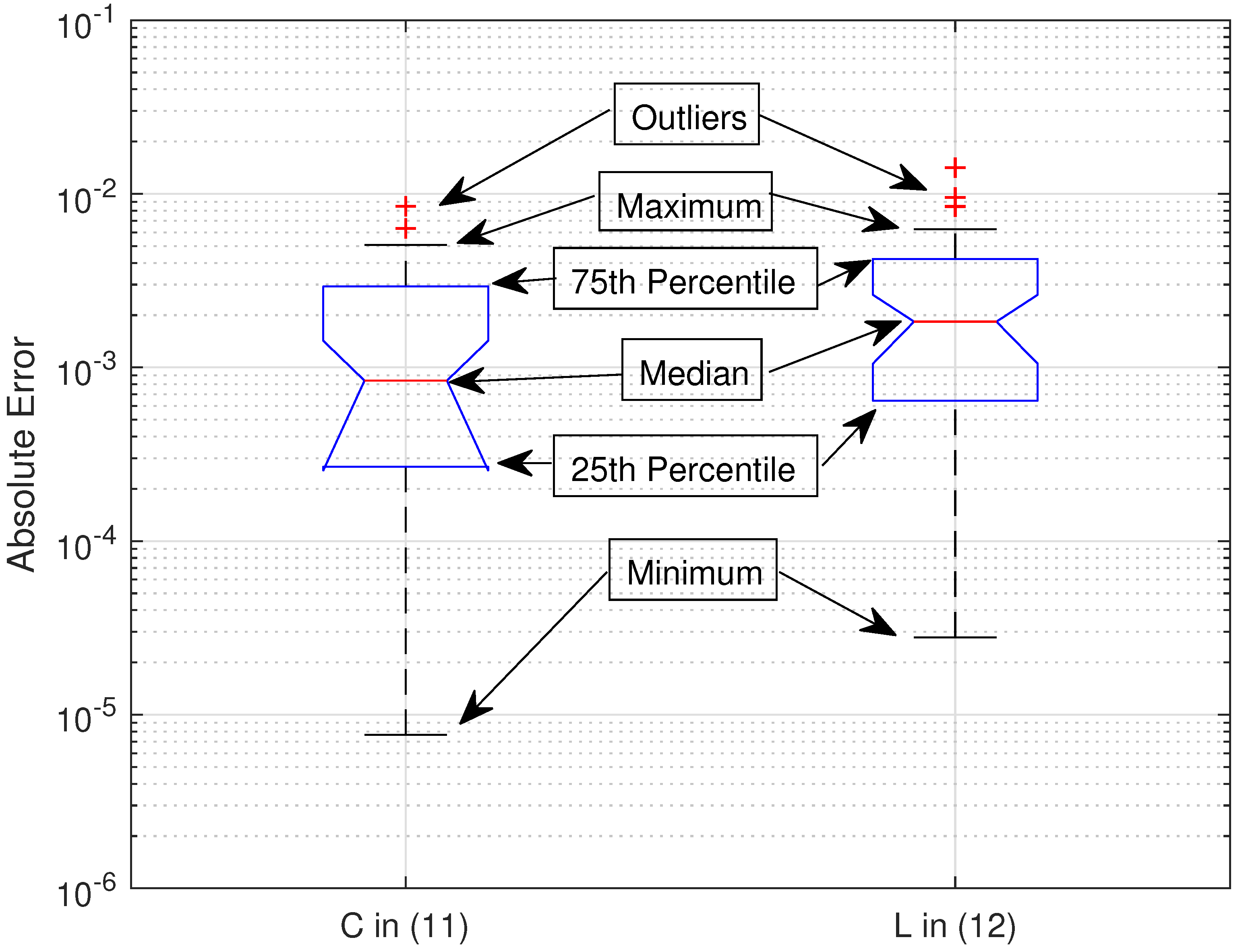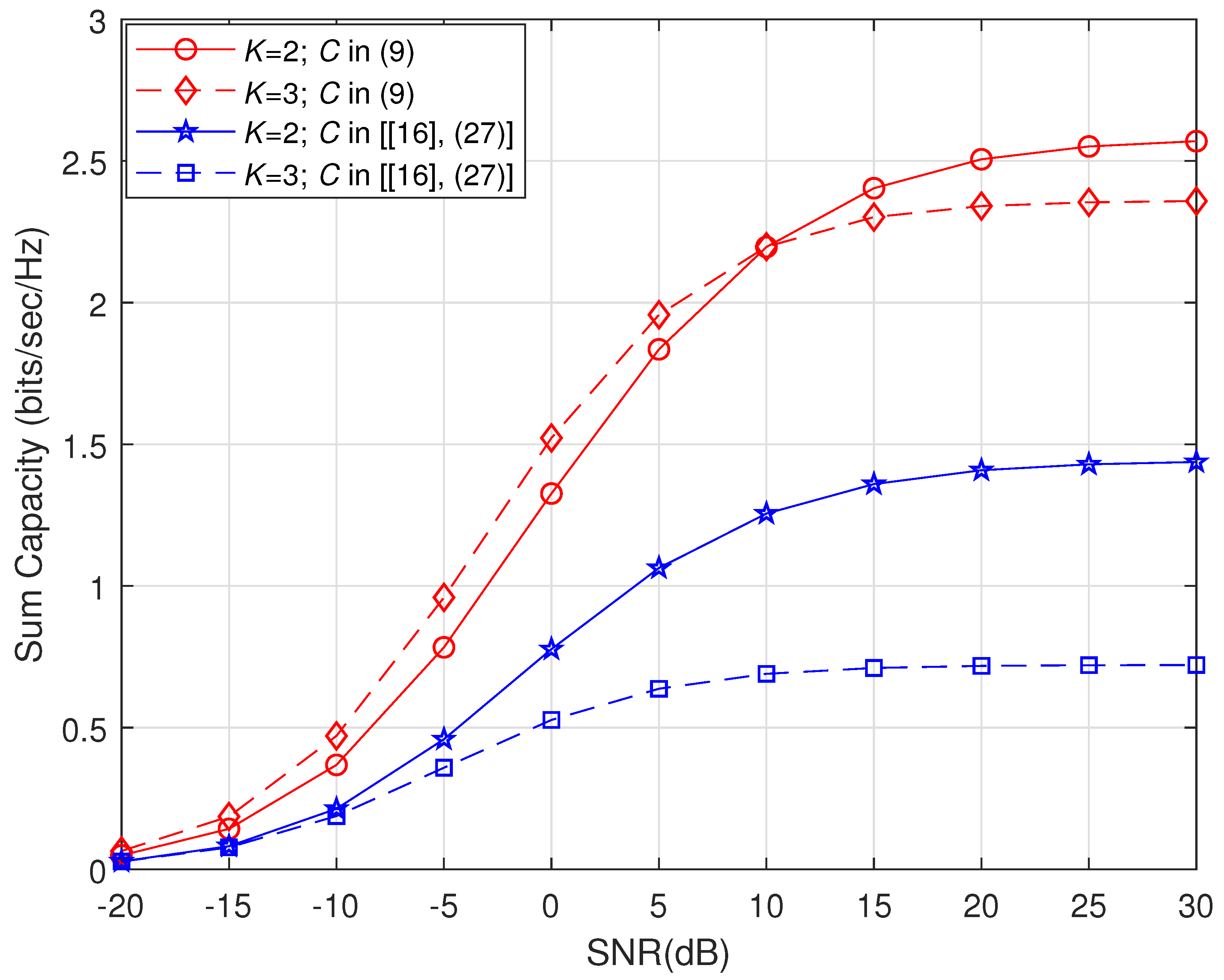Beamforming Using Exact Evaluation of Leakage and Ergodic Capacity of MU-MIMO System
Abstract
:1. Introduction
- deriving tractable, simple, and ‘exact’ closed-form solutions of the ergodic capacity and leakage rate. Our solutions relax the assumption of orthonormal and orthogonal transmit beamforming vectors, while they account for colored channels of arbitrary dimension, distinct correlation matrices, and indefinite eigenvalue structures. Furthermore, the proposed solutions are generic and applicable for any antenna diversity model,
- demonstrating the derived closed-form expressions on a downlink broadcast MU-MIMO system. We also outline the design of transmitting beamformers by selecting sum-capacity and/or sum-leakage rate as objective functions and thereby employ a maximization problem under power loading constraints, and
- showcasing the efficacy of proposed results on several important works in the physical layer domain of communication systems.
2. The Main Results
3. Application Example and Discussion
3.1. Validation of the Closed-Form Expressions
3.2. Beamforming Using the Closed-Form Expressions
| Algorithm 1 Construct of Beamformer |
|
4. Conclusions
Author Contributions
Funding
Institutional Review Board Statement
Informed Consent Statement
Data Availability Statement
Acknowledgments
Conflicts of Interest
Appendix A
Appendix B
References
- Grenander, U.; Pollak, H.O.; Slepian, D. The distribution of quadratic forms in normal variates: A small sample theory with applications to spectral analysis. J. Soc. Ind. Appl. Math. 1959, 7, 374–401. [Google Scholar] [CrossRef]
- Imhof, J.P. Computing the distribution of quadratic forms in normal variables. Biometrika 1961, 48, 419–426. [Google Scholar] [CrossRef] [Green Version]
- Shah, B.K. Distribution of definite and of indefinite quadratic forms from a non-central normal distribution. Ann. Math. Stat. 1963, 34, 186–190. [Google Scholar] [CrossRef]
- Robinson, J. The distribution of a general quadratic form in normal variates. Aust. J. Statist. 1965, 7, 110–114. [Google Scholar] [CrossRef]
- Rice, S.O. Distribution of quadratic forms in normal random variables—Evaluation by numerical integration. SIAM J. Sci. Stat. Comput. 1980, 1, 438–448. [Google Scholar] [CrossRef]
- Mathai, A.M.; Provost, S.B. Quadratic Forms in Random Variables; Marcel Dekker: New York, NY, USA, 1992. [Google Scholar]
- Al-Naffouri, T.Y.; Moinuddin, M.; Ajeeb, N.; Hassibi, B.; Moustakas, A.L. On the distribution of indefinite quadratic forms in Gaussian random variables. IEEE Trans. Commun. 2016, 64, 153–165. [Google Scholar] [CrossRef]
- Eshteiwi, K.; Kaddoum, G.; Alam, M.S. Ergodic capacity analysis of full duplex relaying in the presence of co-channel interference in V2V communications. Sensors 2020, 20, 261. [Google Scholar] [CrossRef] [PubMed] [Green Version]
- Sadek, M.; Tarighat, A.; Sayed, A.H. A leakage-based precoding scheme for downlink multi-user MIMO channels. IEEE Trans. Wirel. Commun. 2007, 6, 1711–1721. [Google Scholar] [CrossRef]
- Li, Y.; Guo, J.; Niu, K.; Dong, C. Joint optimization of beamforming and base station clustering based on leakage rate. IEEE Wirel. Commun. Lett. 2017, 7, 432–435. [Google Scholar] [CrossRef]
- Furrer, S.; Coronel, P.; Dahlhaus, D. Simple ergodic and outage capacity expressions for correlated diversity Ricean fading channels. IEEE Trans. Wirel. Commun. 2006, 5, 1606–1609. [Google Scholar] [CrossRef]
- Hamdi, K.A. Capacity of MRC on correlated Rician fading channels. IEEE Trans. Commun. 2008, 56, 708–711. [Google Scholar] [CrossRef] [Green Version]
- Hamdi, K.A. A useful lemma for capacity analysis of fading interference channels. IEEE Trans. Commun. 2010, 58, 411–416. [Google Scholar] [CrossRef]
- Basnayaka, D.A.; Smith, P.J.; Martin, P.A. Ergodic sum capacity of macrodiversity MIMO systems in flat Rayleigh fading. IEEE Trans. Inf. Theory 2013, 59, 5257–5270. [Google Scholar] [CrossRef] [Green Version]
- Almradi, A.; Hamdi, K.A. MIMO full-duplex relaying in the presence of co-channel interference. IEEE Trans. Veh. Technol. 2016, 66, 4874–4885. [Google Scholar] [CrossRef] [Green Version]
- Tan, W.; Jin, S.; Wang, J.; Matthaiou, M. Achievable sum-rate of multiuser massive MIMO downlink in Ricean fading channels. In Proceedings of the 2015 IEEE International Conference on Communications (ICC), London, UK, 8–12 June 2015; pp. 1453–1458. [Google Scholar]
- Couillet, R.; Debbah, M. Random Matrix Methods for Wireless Communications; Cambridge University Press: Cambridge, NY, USA, 2011. [Google Scholar]
- Bankey, V.; Upadhyay, P.K. Ergodic Capacity of Multiuser Hybrid Satellite-Terrestrial Fixed-Gain AF Relay Networks with CCI and Outdated CSI. IEEE Trans. Veh. Technol. 2018, 67, 4666–4671. [Google Scholar] [CrossRef]
- Al-Hussaibi, W.A.; Ali, F.H. A Closed-Form Approximation of Correlated Multiuser MIMO Ergodic Capacity With Antenna Selection and Imperfect Channel Estimation. IEEE Trans. Veh. Technol. 2018, 67, 5515–5519. [Google Scholar] [CrossRef]
- Hassan, A.K.; Moinuddin, M.; Al-Saggaf, U.M.; Al-Naffouri, T.Y. Performance Analysis of Beamforming in MU-MIMO Systems for Rayleigh Fading Channels. IEEE Access 2017, 5, 3709–3720. [Google Scholar] [CrossRef] [Green Version]
- Hassan, A.K.; Moinuddin, M.; Al-Saggaf, U.M. Sum Ergodic Capacity Analysis Using Asymptotic Design of Massive MU-MIMO Systems. Wirel. Pers. Commun. 2018, 100, 1743–1752. [Google Scholar] [CrossRef]
- Hassan, A.K.; Moinuddin, M.; Al-Saggaf, U.M.; Aldayel, O.; Davidson, T.N.; Al-Naffouri, T.Y. Performance Analysis and Joint Statistical Beamformer Design for Multi-User MIMO Systems. IEEE Commun. Lett. 2020, 24, 2152–2156. [Google Scholar] [CrossRef]
- Sadek, M.; Tarighat, A.; Sayed, A.H. Active Antenna Selection in Multiuser MIMO Communications. IEEE Trans. Signal Process. 2017, 55, 1498–1510. [Google Scholar] [CrossRef]
- Al-Naffouri, T.Y. Scaling of the minimum of iid random variables. Signal Process. 2009, 89, 1830–1834. [Google Scholar] [CrossRef]
- Mohammadkarimi, M.; Mahboobi, B.; Ardebilipour, M. Optimal Spectrum Sensing in Fast Fading Rayleigh Channel for Cognitive Radio. IEEE Commun. Lett. 2011, 15, 1032–1034. [Google Scholar] [CrossRef]
- Mursia, P.; Atzeni, I.; Gesbert, D.; Cottatellucci, L. Covariance Shaping for Massive MIMO Systems. In Proceedings of the 2018 IEEE Global Communications Conference (GLOBECOM), Abu Dhabi, United Arab Emirates, 9–13 December 2018; pp. 1–6. [Google Scholar]
- Goldsmith, A.; Jafar, S.A.; Jindal, N.; Vishwanath, S. Capacity limits of MIMO channels. IEEE J. Sel. Areas Commun. 2003, 21, 684–702. [Google Scholar] [CrossRef] [Green Version]
- Zhang, Q.; Li, Q.; Qin, J. Robust Beamforming for Nonorthogonal Multiple-Access Systems in MISO Channels. IEEE Trans. Veh. Technol. 2016, 65, 10231–10236. [Google Scholar] [CrossRef]
- Verde, F.; Scaglione, A.; Darsena, D.; Gelli, G. An amplify-and-forward scheme for spectrum sharing in cognitive radio channels. IEEE Trans. Wirel. Commun. 2015, 14, 5629–5642. [Google Scholar] [CrossRef]
- Darsena, D.; Gelli, G.; Verde, F. An opportunistic spectrum access scheme for multicarrier cognitive sensor networks. IEEE Sens. J. 2017, 17, 2596–2606. [Google Scholar] [CrossRef]
- Xia, X.; Wu, G.; Liu, J.; Li, S. Leakage-based user scheduling in MU-MIMO broadcast channel. Sci. China Ser. Inf. Sci. 2009, 52, 2259–2268. [Google Scholar] [CrossRef]
- Kim, H.; Lee, S.; Lee, K.; Lee, I. Transmission Schemes Based on Sum Rate Analysis in Distributed Antenna Systems. IEEE Trans. Wirel. Commun. 2012, 11, 1201–1209. [Google Scholar] [CrossRef] [Green Version]
- Optimization Toolbox User’s Guide; The Math Works, Inc.: Natick, MA, USA, 2018.
- Yilmaz, F.; Alouini, M.S. A Unified MGF-Based Capacity Analysis of Diversity Combiners over Generalized Fading Channels. IEEE Trans. Commun. 2012, 60, 862–875. [Google Scholar] [CrossRef] [Green Version]
- Lee, N.; Morales-Jimenez, D.; Lozano, A.; Heath, R.W. Spectral Efficiency of Dynamic Coordinated Beamforming: A Stochastic Geometry Approach. IEEE Trans. Wirel. Commun. 2015, 14, 230–241. [Google Scholar] [CrossRef] [Green Version]
- Jeffrey, A.; Zwillinger, D. (Eds.) Gradshteyn and Ryzhik, Table of Integrals, Series, and Products, 7th ed.; Elsevier: Amsterdam, The Netherlands, 2007. [Google Scholar]






Publisher’s Note: MDPI stays neutral with regard to jurisdictional claims in published maps and institutional affiliations. |
© 2021 by the authors. Licensee MDPI, Basel, Switzerland. This article is an open access article distributed under the terms and conditions of the Creative Commons Attribution (CC BY) license (https://creativecommons.org/licenses/by/4.0/).
Share and Cite
Hassan, A.K.; Moinuddin, M. Beamforming Using Exact Evaluation of Leakage and Ergodic Capacity of MU-MIMO System. Sensors 2021, 21, 6792. https://doi.org/10.3390/s21206792
Hassan AK, Moinuddin M. Beamforming Using Exact Evaluation of Leakage and Ergodic Capacity of MU-MIMO System. Sensors. 2021; 21(20):6792. https://doi.org/10.3390/s21206792
Chicago/Turabian StyleHassan, Ahmad Kamal, and Muhammad Moinuddin. 2021. "Beamforming Using Exact Evaluation of Leakage and Ergodic Capacity of MU-MIMO System" Sensors 21, no. 20: 6792. https://doi.org/10.3390/s21206792
APA StyleHassan, A. K., & Moinuddin, M. (2021). Beamforming Using Exact Evaluation of Leakage and Ergodic Capacity of MU-MIMO System. Sensors, 21(20), 6792. https://doi.org/10.3390/s21206792





